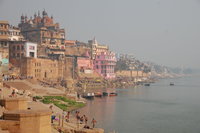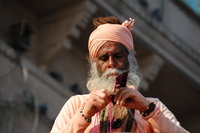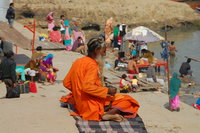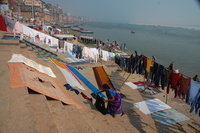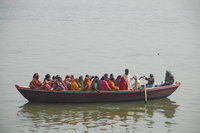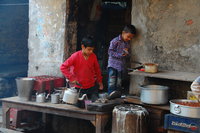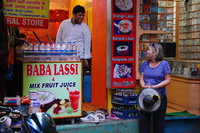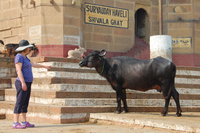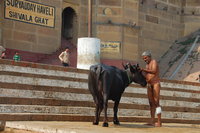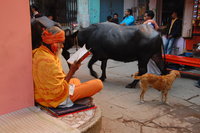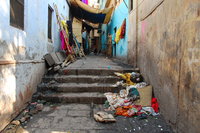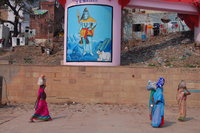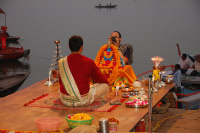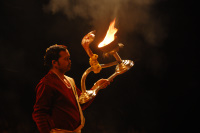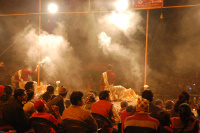On our last day in Khajuraho, the guy who had served us breakfast every
morning met us with a big smile.
"Tomorrow, breakfast, banana lassi."
This confused us for two reasons, firstly, we always had coffee for breakfast
and secondly, we were leaving that day.
"No, we are leaving, taking train, tomorrow not here."
"Yes, yes, tomorrow, breakfast, banana lassi."
"No" we argued, utilising that time-honoured didactic
technique of repetition, "today checkout, leaving,
leaving."
The guy looked confused and wandered off muttering to himself
"Tomorrow, breakfast, Varanasi..."
The twelve hour journey from Khajuraho to Varanasi was largely uneventful. What we did not expect was to be in a carriage full of Chinese tourists. Upon surfacing the next morning and much to the amusement of an Indian across the carriage, Megan was quick to declare that the Chinese are more noisy than the Indians! It really took us back to our time in China. After 11 hours, the train was in serious danger of arriving on time, but we snatched defeat from the jaws of victory by sitting about 100m outside Varanasi station for 40 minutes. All the locals got off the train and walked the last bit. The tourists sat and waited.
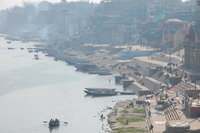
Our hotel in Varanasi is situated right on the banks of the Ganges and we have a view of the river from our room - balcony no less. There are ghats in both directions as far as the eye can see. In reality, the eye can not see very far due to the pals of smoke rising from some of the ghats, but more on that later. Since we are in the heart of the old town in a warren of narrow alleyways that are hard to navigate, the hotel helpfully provided us with a photocopied map. Some of the useful things highlighted on the map (in no particular order, honest) are:
So we should not go short of tourist attractions.
The hotel does not seem to have a man who hammers. Perhaps they feel that, being located in the middle of a metropolis, such things are superfluous. Most of the time we are kept awake by the wailing of priests, the howl of stray dogs, boats with tractor engines and the scampering of monkeys. The owners have thought to provide a man who angle-grinds though, just in case!
Near our hotel we found a nice little cafe that serves a great Americano. Inside is a small shop owned by an even smaller man. He carves pictures and patterns on to bamboo and then inks them in. He told us how long it takes to make each one. Based on what he told us and how much stock he had, he must have been about 200 years old. However, there is a lad working in the hotel who claims to be a 300 year old vampire, so anything is possible.
Varanasi is reputed to be the oldest continuously inhabited city in the world; of course, this may not be true. It is claimed that religious ceremonies have been carried out here continuously since 600BC - which might explain the vampires. The devout call the place Kashi, the City of Light. They say it was founded by Shiva and it is considered central to the Hindu faith. Irrespective of all of this, what is certainly true is that it is one of the dirtiest cities we have ever seen. As usual when encountering indigenous peoples, they want to know what we think of their country and, more specifically, their city. Hmmm! What to say? How about; it is overcrowded, filthy and it stinks? For some reason, Megan has taken quite a shine to the place - go figure. Steve is starting to show weakness and is getting rather short-tempered with the locals. Away from the irritating and persistent touts and the mountains of excrement and garbage, the inherent Hindu friendliness saves the day and we cling to our sanity with barely a week left before we return home.
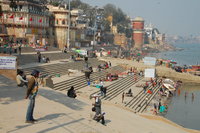
The Varanasi waterfront along the Ganges is lined with ghats for about 5 miles. It is possible (although time consuming) to walk the entire length along the steps. To do so is to run the gauntlet of a wide variety of people competing for your attention. We resolved to walk the distance, but split over two days. Progress is impeded not only by the people and the sights but also by the constant need to watch where you are putting your feet.
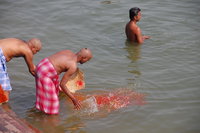
We spent a total of three days ambling along the ghats observing the day to day life of the people who hang out there. This seems to include those taking a bath, workers from the local laundry, boat rowing touts, priests and pilgrims. In addition there is a significant number of people who are in the last stages of life and who believe they will attain instant enlightenment should they die here. As a result, there are a lot of elderly, ill and infirm struggling up and down the steps and into the water, often aided by family members. It is also believed that the waters of the Ganges can cure all ills. This is despite the Indian government realising that bathing in and drinking the water is causing all sorts of health problems. Even if you believe in the curative powers of the river, there is a net damage to health.
We had intended to take some washing to the local laundry but, having seen it being thrashed against stones in the Ganges just down-stream from where the water buffalos go to relieve themselves, we have decided we can manage until we get home.
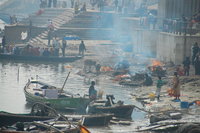
Of course, Varanasi is world famous for the burning ghats where the Untouchables (known as Doms) are responsible for dispatching bodies to the hereafter by burning them on wood pyres on the banks of the river. Other than the distant smoke, the first we saw of this were the enormous piles of wood in the surrounding streets being sold by weight to grieving families.
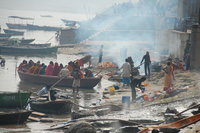
Apparently, above the main burning ghat is a hostel where family members can stay before the loved one is dispatched. On the day of the ceremony, a nominated family member is shaved and then bathed in the Ganges. This person then dresses in white robes and enters the local temple where a flame has been burning for 3,500 years. Some burning brush is then brought out and the funeral pyre is ignited. It seems as though a number of family members are generally in attendance throughout.
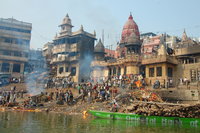
It was plain to see the bodies laid on top of neatly stacked piles of wood and shrouded in smoke and flames. From time to time, the attendants would poke an errant limb back into the flames or douse part of the body in some kind of oil to aid the burning. We had positioned ourselves up-wind for obvious reasons, but there were plenty of people down by the fires. One chap who had just finished bathing in the Ganges used the fire to dry himself - a strangely pragmatic slant to an otherwise deeply religious occasion.
There are some interesting aspects to this cremation ritual. Some people are not permitted to be cremated, for example lepers. The reason for this is that it is believed that to do so would spread disease. Instead, the bodies are simply dumped in the river! Children under 10 are also excluded. One day, we observed a somber group of people standing around and one man seemingly free-diving in the river. We were told that a baby had been dropped in the water by accident. It was ironic to think that, even if they did find it, they would pretty soon be putting it back.
Whilst the Doms are responsible for managing the fires and ensuring that the bodies are dispatched correctly, it is said that they are fairly well off people. Apparently there is a chief Dom who is very rich and all the others work for him (this is a common modus operandi throughout the caste system). It is traditional for Hindu women to be burned whilst wearing their jewelry and we did see the Doms raking through yesterday's ashes looking for same, which they get to keep (after the head honcho has taken his cut of course).
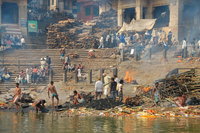
For some reason which is unclear in such a public ceremony, it is frowned on to take pictures, so what you see here is as close as we went with the camera. Some touts seem to have developed rather aggressive tactics to try and blackmail tourists out of money and at one point it seemed best to beat a hasty retreat, not least because we were standing under a rather rickety wood pile. We had a man row us down the river past the ghat and were able to observe more easily.
In total, we probably saw about a dozen bodies being burned during our time in Varanasi, which is probably enough for anybody. Occasionally we had to move away when the smoke got too bad or the ash started falling on us and, despite vowing not to get any laundry done here, we had to change our clothes daily due to the smell they took on.
One evening, we attended the so called Puja Ceremony on the main ghat. This is a dedication to Lord Shiva, the Ganges, the Sun and to Fire. It is rather dramatic if a little repetitive involving lots of singing and chanting an different things being set on fire.
We have hit upon a small technical problem right at the end of our trip. The travel guides often advise you to "invest" in a surge protector due to the unreliable nature of Indian electricity. A degree in electronics empowered Steve to ignore this suggestion, only to have the laptop power supply destroyed by errant voltage. Brown liquids may be ubiquitous in Varanasi, but seeping out of the charger can not be right! Any update from this point on will be typed on a phone and we can't add any more photos. Actually, life really is too short for that, so we will probably draw this blog entry to a close now.
We are due to catch an overnight train from Varanasi back to Delhi, where we have a day to hoover up any cheap souvenirs before catching the flight back to London. We are hoping to be back in Bristol late on 11th although there is a good chance it will end up being 12th.
As usual, we will post a final update when we get home that will include some of our thoughts on the trip and conclusions about what we have seen. There should also be some more photos. Until then, as ever, thanks for sticking with us.
